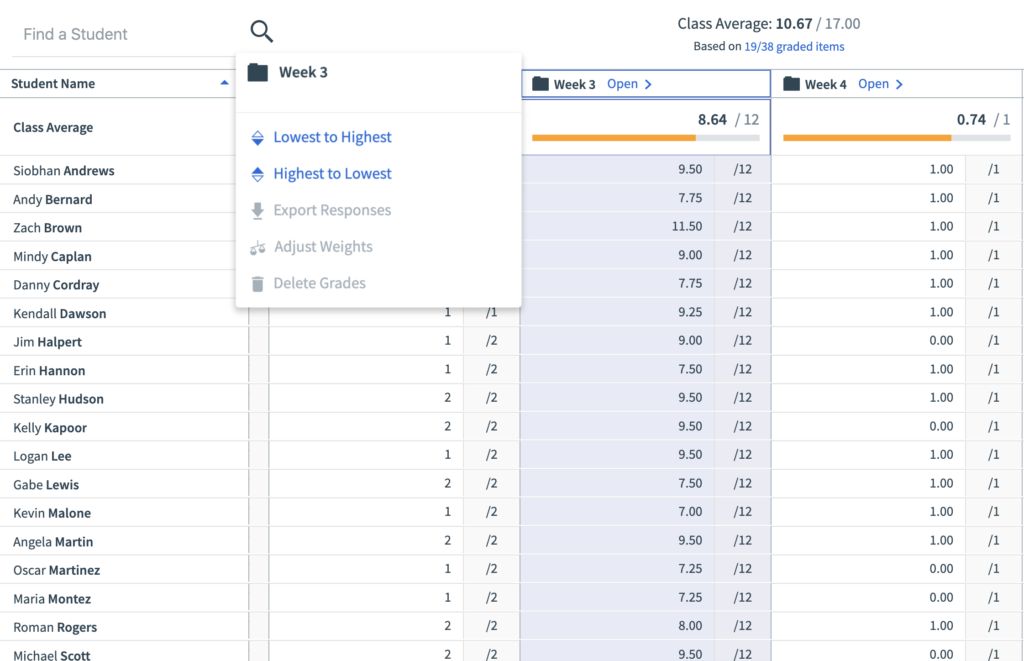This ultimate guide to grading student work offers strategies, tips and examples to help you make the grading process more efficient and effective for you and your students. The right approach can save time for other teaching tasks, like lecture preparation and student mentoring.
Grading is one of the most painstaking responsibilities of postsecondary teaching. It’s also one of the most crucial elements of the educational process. Even with an efficient system, grading requires a great deal of time—and even the best-laid grading systems are not entirely immune to student complaints and appeals. This guide explores some of the common challenges in grading student work along with proven grading techniques and helpful tips to communicate expectations and set you and your students up for success, especially those who are fresh out of high school and adjusting to new expectations in college or university.
What is grading?
Grading is only one of several indicators of a student’s comprehension and mastery, but understanding what grading entails is essential to succeeding as an educator. It allows instructors to provide standardized measures to evaluate varying levels of academic performance while providing students valuable feedback to help them gauge their own understanding of course material and skill development. Done well, effective grading techniques show learners where they performed well and in what areas they need improvement. Grading student work also gives instructors insights into how they can improve the student learning experience.
Grading challenges: Clarity, consistency and fairness
No matter how experienced the instructor is, grading student work can be tricky. No such grade exists that perfectly reflects a student’s overall comprehension or learning. In other words, some grades end up being inaccurate representations of actual comprehension and mastery. This is often the case when instructors use an inappropriate grading scale, such as a pass/fail structure for an exam, when a 100-point system gives a more accurate or nuanced picture.
Grading students’ work fairly but consistently presents other challenges. For example, grades for creative projects or essays might suffer from instructor bias, even with a consistent rubric in place. Instructors can employ every strategy they know to ensure fairness, accessibility, accuracy and consistency, and even so, some students will still complain about their grades. Handling grade point appeals can pull instructors away from other tasks that need their attention.
Many of these issues can be avoided by breaking things down into logical steps. First, get clear on the learning outcomes you seek to achieve, then ensure the coursework students will engage in is well suited to evaluating those outcomes and last, identify the criteria you will use to assess student performance.
What are some grading strategies for educators?
There are a number of grading techniques that can alleviate many problems associated with grading, including the perception of inconsistent, unfair or arbitrary practices. Grading can use up a large portion of educators’ time. However, the results may not improve even if the time you spend on it does. Grading, particularly in large class sizes, can leave instructors feeling burnt out. Those who are new to higher education can fall into a grading trap, where far too much of their allocated teaching time is spent on grading. As well, after the graded assignments have been handed back, there may be a rush of students wanting either to contest the grade, or understand why they got a particular grade, which takes up even more of the instructor’s time. With some dedicated preparation time, careful planning and thoughtful strategies, grading student work can be smooth and efficient. It can also provide effective learning opportunities for the students and good information for the instructor about the student learning (or lack of) taking place in the course. These grading strategies can help instructors improve their accuracy in capturing student performance.
Establishing clear grading criteria
Setting grading criteria helps reduce the time instructors spend on actual grading later on. Such standards add consistency and fairness to the grading process, making it easier for students to understand how grading works. Students also have a clearer understanding of what they need to do to reach certain grade levels.
Establishing clear grading criteria also helps instructors communicate their performance expectations to students. Furthermore, clear grading strategies give educators a clearer picture of content to focus on and how to assess subject mastery. This can help avoid so-called ‘busywork’ by ensuring each activity aligns clearly to the desired learning outcome.
Step 1: Determine the learning outcomes and the outputs to measure performance. Does assessing comprehension require quizzes and/or exams, or will written papers better capture what the instructor wants to see from students’ performance? Perhaps lab reports or presentations are an ideal way of capturing specific learning objectives, such as behavioral mastery.
Step 2: Establish criteria to determine how you will evaluate assigned work. Is it precision in performing steps, accuracy in information recall, or thoroughness in expression? To what extent will creativity factor in the assessment?
Step 3: Determine the grade weight or value for each assignment. These weights represent the relative importance of each assignment toward the final grade and a student’s GPA. For example, how much will the final exam count relative to a research paper or essay? Once the weights are in place, it’s essential to stratify grades that distinguish performance levels. For example:
- A grade = excellent
- B grade = very good
- C grade = adequate
- D grade = poor but passing
- F grade = unacceptable
Making grading efficient
Grading efficiency depends a great deal on devoting appropriate amounts of time to certain grading tasks. For instance, some assignments deserve less attention than others. That’s why some outcomes, like attendance or participation work, can help save time by getting a simple pass/fail grade or acknowledgment of completion using a check/check-plus/check-minus scale.
However, other assignments like tests or papers need to show more in-depth comprehension of the course material. These items need more intricate scoring schemes and require more time to evaluate, especially if student responses warrant feedback.
When appropriate, multiple-choice questions can provide a quick grading technique. They also provide the added benefit of grading consistency among all students completing the questions. However, multiple-choice questions are more difficult to write than most people realize. These questions are most useful when information recall and conceptual understanding are the primary learning outcomes.
Instructors can maximize their time for more critical educational tasks by creating scheduled grading strategies and sticking to it. A spreadsheet is also essential for calculating many students’ grades quickly and exporting data to other platforms.
Making grading more meaningful in higher education

Grading student work is more than just routine, despite what some students believe. The better students understand what instructors expect them to take away from the course, the more meaningful the grading structure will be. Meaningful grading strategies reflect effective assignments, which have distinct goals and evaluation criteria. It also helps avoid letting the grading process take priority over teaching and mentoring.
Leaving thoughtful and thorough comments does more than rationalize a grade. Providing feedback is another form of teaching and helps students better understand the nuances behind the grade. Suppose a student earns a ‘C’ on a paper. If the introduction was outstanding, but the body needed improvement, comments explaining this distinction will give a clearer picture of what the ‘C’ grade represents as opposed to ‘A-level’ work.
Instructors should limit comments to elements of their work that students can actually improve or build upon. Above all, comments should pertain to the original goal of the assignment. Excessive comments that knit-pick a student’s work are often discouraging and overwhelming, leaving the student less able or willing to improve their effort on future projects. Instead, instructors should provide comments that point to patterns of strengths and areas needing improvement. It’s also helpful to leave a summary comment at the end of the assignment or paper.
Maintaining a complaint-free grading system
In many instances, an appropriate response to a grade complaint might simply be, “It’s in the syllabus.” Nevertheless, one of the best strategies to curtail grade complaints is to limit or prohibit discussions of grades during class time. Inform students that they can discuss grades outside of class or during office hours.
Instructors can do many things before the semester or term begins to reduce grade complaints. This includes detailed explanations in the grading system’s syllabus, the criteria for earning a particular letter grade, policies on late work, and other standards that inform grading. It also doesn’t hurt to remind students of each assignment’s specific grading criteria before it comes due. Instructors should avoid changing their grading policies; doing so will likely lead to grade complaints.
Assigning student grades

Since not all assignments may count equally toward a final course grade, instructors should figure out which grading scales are appropriate for each assignment. They should also consider that various assignments assess student work differently; therefore, their grading structure should reflect those differences. For example, some exams might warrant a 100-point scale rather than a pass/fail grade. Requirements like attendance or class participation might be used to reward effort; therefore, merely completing that day’s requirement is sufficient.
Grading essays and open-ended writing
Some writing projects might seem like they require more subjective grading standards than multiple-choice tests. However, instructors can implement objective standards to maintain consistency while acknowledging students’ individual approaches to the project.
Instructors should create a rubric or chart against which they evaluate each assignment. A rubric contains specific grading criteria and the point value for each. For example, out of 100 points, a rubric specifies that a maximum of 10 points are given to the introduction. Furthermore, an instructor can include even more detailed elements that an introduction should include, such as a thesis statement, attention-getter, and preview of the paper’s main points.
Grading creative work
While exams, research papers, and math problems tend to have more finite grading criteria, creative works like short films, poetry, or sculptures can seem more difficult to grade. Instructors might apply technical evaluations that adhere to disciplinary standards. However, there is the challenge of grading how students apply their subject talent and judgment to a finished product.
For creative projects that are more visual, instructors might ask students to submit a written statement along with their assignment. This statement can provide a reflection or analysis of the finished product, or describe the theory or concept the student used. This supplement can add insight that informs the grade.
Grading for multi-section courses
Professors or course coordinators who oversee several sections of a course have the added responsibility of managing other instructors or graduate student teaching assistants (TAs) in addition to their own grading. Course directors need to communicate regularly and consistently with all teaching staff about the grading standards and criteria to ensure they are applied consistently across all sections.
If possible, the course director should address students from all sections in one gathering to explain the criteria, expectations, assignments, and other policies. TAs should continue to communicate grading-related information to the students in their classes. They also should maintain contact with each other and the course director to address inconsistencies, stay on top of any changes and bring attention to problems.
To maintain consistency and objectivity across all sections, the course director might consider assigning TAs to grade other sections besides their own. Another strategy that can save time and maintain consistency is to have each TA grade only one exam portion. It’s also vital to compare average grades and test scores across sections to see if certain groups of students are falling behind or if some classes need changes in their teaching strategies.
Types of grading
- Absolute grading: A grading system where instructors explain performance standards before the assignment is completed. grades are given based on predetermined cutoff levels. Here, each point value is assigned a letter grade. Most schools adopt this system, where it’s possible for all students to receive an A.
- Relative grading: An assessment system where higher education instructors determine student grades by comparing them against those of their peers.
- Weighted grades: A method ussed in higher education to determine how different assessments should count towards the final grade. An instructor may choose to make the results of an exam worth 50 percent of a student’s total class grade, while assignments account for 25 percent and participation marks are worth another 25 percent.
- Grading on a curve: This system adjusts student grades to ensure that a test or assignment has the proper distribution throughout the class (for example, only 20% of students receive As, 30% receive Bs, and so on), as well as a desired total average (for example, a C grade average for a given test). We’ve covered this type of grading in more detail in the blog post The Ultimate Guide to Grading on A Curve.
Ungrading
Ungrading is an education model that prioritizes giving feedback and encouraging learning through self-reflection rather than a letter grade. Some instructors argue that grades cannot objectively assess a student’s work. Even when calculated down to the hundredth of a percentage point, a “B+” on an English paper doesn’t paint a complete picture about what a student can do, what they understand or where they need help. Alfie Kohn, lecturer on human behavior, education, and parenting, says that the basis for grades is often subjective and uninformative. Even the final grade on a STEM assignment is more of a reflection of how the assignment was written, rather than the student’s mastery of the subject matter. So what are educators who have adopted ungrading actually doing? Here are some practices and strategies that decentralize the role of assessments in the higher ed classroom.
- Frequent feedback: Rather than a final paper or exam, encourage students to write letters to reflect on their progress and learning throughout the term. Students are encouraged to reflect on and learn from both their successes and their failures, both individually and with their peers. In this way, conversations and commentary become the primary form of feedback, rather than a letter grade.
- Opportunities for self-reflection: Open-ended questions help students to think critically about their learning experiences. Which course concepts have you mastered? What have you learned that you are most excited about? Simple questions like these help guide students towards a more insightful understanding of themselves and their progress in the course.
- Increasing transparency: Consider informal drop-in sessions or office hours to answer student questions about navigating a new style of teaching and learning. The ungrading process has to begin from a place of transparency and openness in order to build trust. Listening to and responding to student concerns is vital to getting students on board. But just as important is the quality of feedback provided, ensuring both instructors and students remain on the same page.
Grading on a curve
Instructors will grade on a curve to allow for a specific distribution of scores, often referred to as “normal distribution.” To ensure there is a specific percentage of students receiving As, Bs, Cs and so forth, the instructor can manually adjust grades.
When displayed visually, the distribution of grades ideally forms the shape of a bell. A small number of students will do poorly, another small group will excel and most will fall somewhere in the middle. Students whose grades settle in the middle will receive a C-average. Students with the highest and the lowest grades fall on either side.
Some instructors will only grade assignments and tests on a curve if it is clear that the entire class struggled with the exam. Others use the bell curve to grade for the duration of the term, combining every score and putting the whole class (or all of their classes, if they have more than one) on a curve once the raw scores are tallied.
How to make your grading techniques easier
Grading is a time-consuming exercise for most educators. Here are some tips to help you become more efficient and to lighten your load.
- Schedule time for grading: Pay attention to your rhythms and create a grading schedule that works for you. Break the work down into chunks and eliminate distractions so you can stay focused.
- Don’t assign ‘busy work’: Each student assignment should map clearly to an important learning outcome. Planning up front ensures each assignment is meaningful and will avoid adding too much to your plate.
- Use rubrics to your advantage: Clear grading criteria for student assignments will help reduce the cognitive load and second guessing that can happen when these tools aren’t in place. Having clear standards for different levels of performance will also help ensure fairness.
- Prioritize feedback: It’s not always necessary to provide feedback on every assignment. Also consider bucketing feedback into what was done well, areas for improvement and ways to improve. Clear, pointed feedback is less time-consuming to provide and often more helpful to students.
- Reward yourself: Grading is taxing work. Be realistic about how much you can do and in what time period. Stick to your plan and make sure to reward yourself with breaks, a walk outside or anything else that will help you refresh.
How Top Hat streamlines grading
There are many tools available to college educators to make grading student work more consistent and efficient. Top Hat’s all-in-one teaching platform allows you to automate a number of grading processes, including tests and quizzes using a variety of different question types. Attendance, participation, assignments and tests are all automatically captured in the Top Hat Gradebook, a sophisticated data management tool that maintains multiple student records.
In the Top Hat Gradebook, you can access individual and aggregate grades at a glance while taking advantage of many different reporting options. You can also sync grades and other reporting directly to your learning management system (LMS).
Conclusion
Grading is one of the most essential components of the teaching and learning experience. It requires a great deal of strategy and thought to be executed well. While it certainly isn’t without its fair share of challenges, clear expectations and transparent practice ensure that students feel included as part of the process and can benefit from the feedback they receive. This way, they are able to track their own progress towards learning goals and course objectives.
Click here to learn more about Gradebook, Top Hat’s all-in-one solution designed to help you monitor student progress with immediate, real-time feedback.


